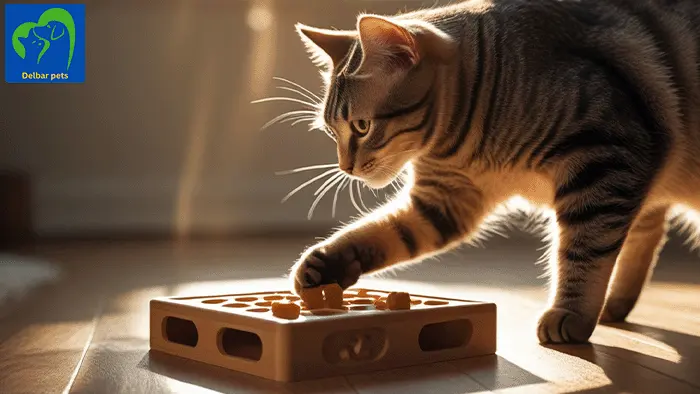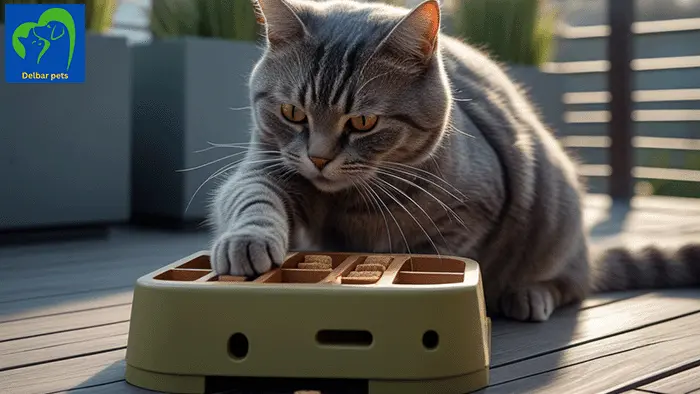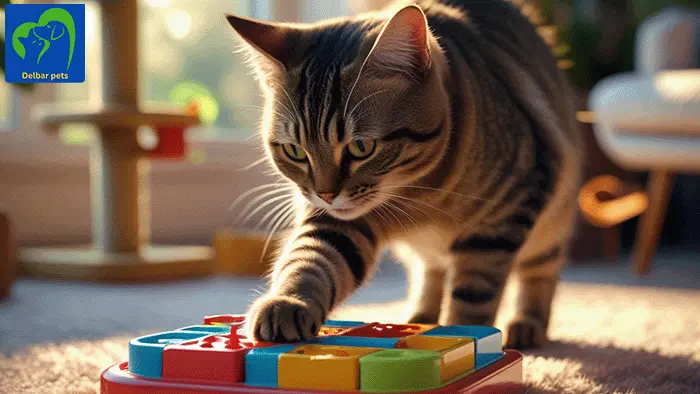Blog

Top 10 Puzzle Toys for Cats That Will Stimulate Their Mind and Keep Them Entertained
Puzzle Toys for Cats
Cats are naturally curious creatures, driven by instinct to hunt, explore, and solve problems. In a domesticated setting, these instincts can go unfulfilled—unless you provide the right kind of stimulation. That’s where puzzle toys for cats come in. These ingenious inventions combine fun and challenge, transforming ordinary playtime into an enriching mental workout.
As a seller of feline enrichment products, introducing interactive cat puzzle toys to your audience isn’t just smart marketing—it’s meeting a crucial need for modern cat parents who want their companions to live happier, healthier, and more fulfilling lives.
Why Cats Need Mental Stimulation
Cats may sleep for up to 16 hours a day, but that doesn’t mean the rest of their time should be idle. Mental stimulation is just as important as physical exercise. Without it, cats can develop behavioral issues such as over-grooming, aggression, or depression.
Mental stimulation mimics the hunting experience. It taps into their predatory instincts—searching, stalking, and problem-solving. When a puzzle toy offers a challenge followed by a reward (like a hidden treat), it mirrors the satisfaction of catching prey.
Signs Your Cat Needs Enrichment
How do you know if your cat is craving more stimulation? Here are a few telltale signs:
- Destructive behavior (scratching furniture, knocking objects)
- Overeating or disinterest in food
- Excessive vocalization or yowling
- Anxiety when alone
- Over-grooming or biting their fur
- Pacing or repetitive behavior
If any of these behaviors sound familiar, your cat may be under-stimulated—and puzzle toys can help.
Benefits of Puzzle Toys for Cats
Let’s break down what makes these toys more than just fun:
- Cognitive Development: Encourages problem-solving and curiosity.
- Stress Reduction: Keeps them busy and distracts from environmental stressors.
- Weight Management: Promotes movement, especially when food is involved.
- Prevent Boredom: Keeps destructive habits at bay.
- Bonding Time: Playing together with your cat fosters emotional connection.
Plus, puzzle toys can be particularly helpful for indoor cats, who may not get the varied stimulation of outdoor environments.
Types of Puzzle Toys for Cats
There’s no one-size-fits-all solution. Here are the most popular types of cat toys for mental stimulation:
| Puzzle Toy Type | Description | Best For |
| Treat Dispensers | Toys that release food or treats after problem-solving | Food-motivated cats |
| Sliding Puzzles | Pieces that need to be moved to reveal a reward | Clever and curious cats |
| Rolling Puzzle Balls | Balls that release treats while rolling | Active cats |
| Stacked Towers | Toys with multiple levels for pawing and chasing | Energetic kittens |
| Electronic Toys | Automatic toys that move or hide objects | Solo play |
DIY Puzzle Toys for Cats
On a budget? No problem. Here are some DIY ideas to stimulate your cat:
- Muffin Tin Puzzle: Place treats in a muffin tray, cover with balls.
- Toilet Roll Challenge: Tape toilet paper rolls together and hide kibble.
- Towel Roll-Up: Hide treats in a towel and roll it up.
Safety Tips:
- Avoid small parts that can be swallowed.
- Supervise the first few sessions.
- Ensure the toy materials are pet-safe and non-toxic.
Best Puzzle Toys for Cats in 2025
Here are some of the top-rated toys that are making waves this year:
| Toy Name | Features | Rating |
| PetSafe SlimCat | Rolling food dispenser, dishwasher-safe | ⭐⭐⭐⭐⭐ |
| Trixie 5-in-1 Activity Center | Multi-puzzle, sturdy design | ⭐⭐⭐⭐ |
| Cat Amazing Classic | Eco-friendly, 3 levels of difficulty | ⭐⭐⭐⭐ |
| Doc & Phoebe’s Hunting Feeder | Mimics hunting behavior | ⭐⭐⭐⭐⭐ |
| SmartyKat Hot Pursuit | Battery-operated, motion-activated | ⭐⭐⭐⭐ |
Each of these options brings something unique to the table—whether it’s mimicking real-life hunting or offering complexity for genius-level cats.
How to Introduce Puzzle Toys to Cats
Cats can be skeptical about new things. Follow this step-by-step approach:
- Start Simple: Use an easy toy or remove barriers from a complex one.
- Use High-Value Treats: Encourage interest by using their favorite reward.
- Demonstrate: Show them how it works (yes, really).
- Short Play Sessions: Begin with 5–10 minutes a day.
- Gradually Increase Difficulty: Once your cat gets the hang of it, up the ante.
Mistakes to Avoid When Using Puzzle Toys
- Using toys that are too advanced right away.
- Leaving the toy out all the time (novelty wears off).
- Using food they don’t like.
- Not cleaning the toy regularly.
Every toy should be a fresh experience—rotate them to maintain interest.
How Puzzle Toys Help with Cat Obesity
Obesity is one of the most common health issues in domestic cats. Puzzle feeders help by:
- Slowing Down Eating: Encourages small, timed portions.
- Promoting Movement: Cats need to work for their food.
- Creating Engagement: Reduces boredom-eating.
Weight management becomes fun, and your feline friend doesn’t even notice they’re “exercising.”
Puzzle Toys and Senior Cats
Older cats need mental stimulation too! However, their mobility may be limited. Opt for:
- Low-impact puzzle trays
- Toys with strong scent appeal
- Simple reward-reveal toys
Senior cats often regain a youthful spark with the right kind of challenge.
Kitten-Friendly Puzzle Toys
Kittens are naturally inquisitive but also impatient. Choose:
- Easy-access puzzles
- Brightly colored toys
- Toys with sound and texture
Their developing brains thrive on tactile, auditory, and visual play.
Puzzle Toys vs. Traditional Toys
| Feature | Puzzle Toys | Traditional Toys |
| Stimulates Mind | ✅ | ❌ |
| Self-Play | ✅ | ✅ |
| Requires Setup | ✅ | ❌ |
| Physical Activity | ✅ | ✅ |
Each has its place. Traditional toys are great for bonding; puzzle toys are perfect for solo time.
Top Brands for Cat Puzzle Toys
When choosing a puzzle toy, brand reputation matters—especially when it concerns your furry friend’s safety and stimulation. Here are some trusted names known for their innovation and pet-focused designs:
- PetSafe®: Known for durable, adjustable difficulty treat dispensers.
- Trixie®: Offers puzzle boards with multiple challenges in one.
- Catit®: Stylish and practical enrichment toys, especially the “Senses” line.
- Doc & Phoebe’s: Invented the indoor hunting feeder that mimics real-life prey.
- Cat Amazing®: Eco-conscious brand with biodegradable puzzle boxes.
Stick with these reputable manufacturers to ensure safety, usability, and effectiveness.
Interactive Tech Puzzle Toys
Tech-savvy pet parents, rejoice! The future of interactive cat puzzle toys includes automation and AI:
- Laser-chasing robots with random patterns.
- Smart feeders with app control and scheduled release.
- Voice-activated treat dispensers.
- Motion-activated toys that trigger only when your cat is nearby.
While traditional puzzles are excellent, these advanced toys are perfect for busy owners who want to keep their pets engaged even when they’re away.
Scent-Based Puzzle Games
Cats experience the world largely through scent. Puzzle toys that incorporate scent-stimulating features offer a whole new level of engagement. Examples include:
- Toys infused with catnip or silvervine.
- Treats that emit strong, natural smells.
- Puzzle mats where you can hide aromatically appealing food.
Scent-based play is ideal for shy or vision-impaired cats.
How Often Should Cats Use Puzzle Toys?
While there’s no one-size-fits-all frequency, general guidelines suggest:
- Daily short sessions of 10–15 minutes.
- Rotating toys weekly to maintain novelty.
- Meal-based puzzle feeders used consistently.
As with exercise in humans, consistency trumps intensity. Small, regular playtime sessions lead to better long-term engagement.
Supervising Your Cat During Play
Some puzzle toys may contain parts that could pose choking hazards or become frustrating. Tips for safe supervision:
- Monitor first-time use of any new toy.
- Remove toys showing signs of wear and tear.
- Avoid unsupervised play with DIY toys that aren’t tested for safety.
Cats should feel challenged but not overwhelmed—your oversight makes all the difference.
Combining Puzzle Toys with Training
Did you know you can teach your cat new tricks and stimulate their mind with puzzle toys?
- Pair treat puzzles with clicker training.
- Use toys as rewards for recall or behavior.
- Introduce commands like “find it” before releasing a toy.
Cats may not be dogs, but they are highly trainable when the motivation (treats!) is right.
Can Puzzle Toys Reduce Anxiety in Cats?
Yes! Enrichment activities like puzzle play can reduce stress and separation anxiety by:
- Distracting the mind from environmental triggers.
- Creating predictable, positive routines.
- Increasing confidence through problem-solving success.
Especially helpful for rescue cats or those who’ve undergone recent life changes (like moving homes or the arrival of a new pet).
Puzzle Toys for Multi-Cat Homes
If you have more than one cat, here’s how to make puzzle toys work without sparking sibling rivalry:
- Provide multiple toys to avoid territorial behavior.
- Supervise closely during shared play sessions.
- Rotate locations to prevent dominance over a “favorite spot.”
Some toys are designed for group play, but in general, cats prefer individual experiences with their own puzzles.
Using Puzzle Toys with Timed Feeders
Want to automate mealtime but keep it fun? Combine puzzle toys with:
- Timed feeders that release treats into puzzles.
- Timed activation toys that mimic hunting times.
- DIY timed drops using slow-release devices and puzzles.
This method is perfect for weight control, slow feeding, and mental stimulation.
Puzzle Toys & Feline Aggression
Believe it or not, a bored cat can be an aggressive cat. Puzzle toys help redirect aggressive tendencies toward healthy outlets:
- Chasing, pawing, and biting toys instead of humans.
- Burning off energy through focused activity.
- Easing tension with positive reinforcement.
When cats have a “job” to do, like solving a puzzle, they’re less likely to lash out.
Are Puzzle Toys Suitable for Indoor Cats Only?
Not at all. While puzzle toys are perfect for indoor cats, they’re also great for outdoor or indoor-outdoor cats:
- Travel puzzles for carriers or car trips.
- Portable games for use in yards or balconies.
- Enrichment stations inside enclosed catios.
Wherever your cat plays, enrichment can follow.
Storage and Hygiene of Puzzle Toys
Keeping your cat’s toys clean and organized ensures both health and longevity:
Cleaning Tips:
- Wash food-based toys after each use.
- Use warm soapy water or dishwasher-safe models.
- Wipe down electronics with non-toxic wipes.
Storage Hacks:
- Keep puzzle toys in a dedicated cat drawer or bin.
- Rotate weekly to prevent boredom.
- Separate food toys from other playthings for cleanliness.
Monitoring Progress with Puzzle Toys
You can actually track your cat’s improvement with puzzles over time:
- Note the time it takes to solve puzzles.
- Introduce harder toys every few weeks.
- Keep a journal of behaviors before and after use.
You’ll be amazed how smarter (and calmer!) your cat becomes.
Reviews from Cat Owners & Experts
Let’s hear it from real cat lovers:
“My cat Luna used to yowl at night—since getting her a treat-dispensing ball, she plays and sleeps like a baby!”
— Jessica M., New York
“As a vet, I recommend puzzle toys for all indoor cats. It’s mental exercise they don’t get elsewhere.”
— Dr. Mark Reynolds, DVM
“We rotate three puzzle feeders, and each of our three cats has a favorite.”
— Anthony & Lisa, Portland
Where to Buy the Best Puzzle Toys
Need a one-stop shop for the best in feline enrichment? Check out:
- Delbar pets (unique puzzles, Triple Play Disc)
- Chewy.com (great variety and quick shipping)
- Amazon (customer reviews and brand variety)
- Petco & PetSmart (in-store pickups available)
- Etsy (for handmade)
Puzzle Toys for Cats
Puzzle toys for cats are no longer just a luxury; they are a necessity. Whether you’re raising a kitten, helping a senior stay sharp, or curbing your kitty’s destructive habits—interactive puzzle toys offer a safe, fun, and incredibly effective way to do it.
Cats are intelligent, emotional beings who thrive when challenged and rewarded. With the right toy and a bit of creativity, your home becomes a playground of enrichment and joy.
FAQs
Do all cats like puzzle toys?
Not all at first! Some may take time to warm up. Start simple and observe their preferences.
How many puzzle toys should my cat have?
Aim for 2–3 rotated regularly. This keeps engagement high and boredom low.
Can puzzle toys replace regular feeding bowls?
Absolutely. Puzzle feeders encourage natural eating habits and slow down fast eaters.
Are puzzle toys good for kittens?
Yes! Just choose simpler designs and monitor closely during play.
Can puzzle toys help with behavioral problems?
Yes, especially issues stemming from boredom, anxiety, or excess energy.
What’s the best time of day to use puzzle toys?
Morning and early evening—mimicking natural hunting hours.
Conclusion
Puzzle toys for cats are the purr-fect blend of entertainment and enrichment. They challenge your cat’s brain, improve their health, and provide much-needed stimulation in today’s often sedentary indoor environments. From kittens to seniors, puzzle toys offer value to every feline.
Whether you’re a devoted cat parent or a pet store owner, it’s time to prioritize puzzle play. Try one today, and watch your cat become happier, healthier, and sharper than ever before.



